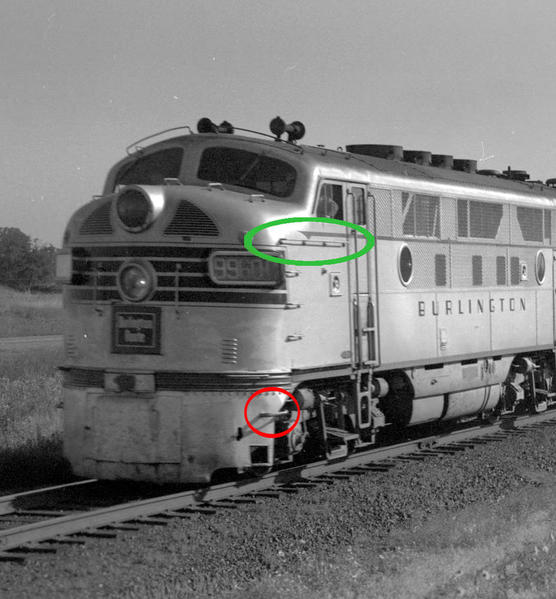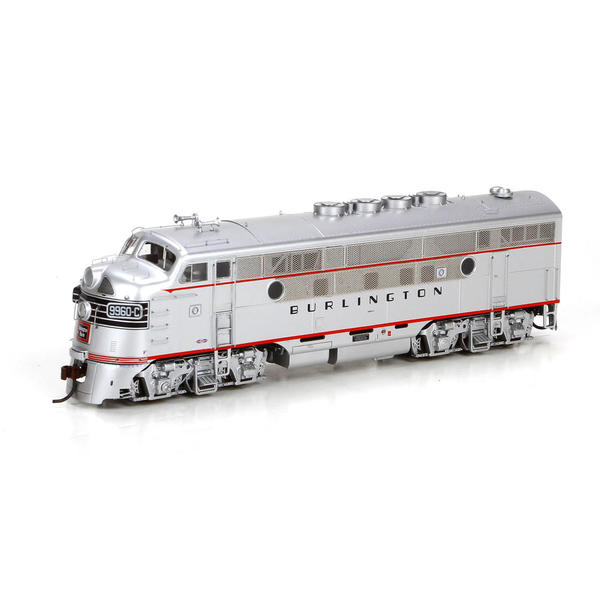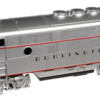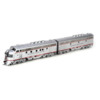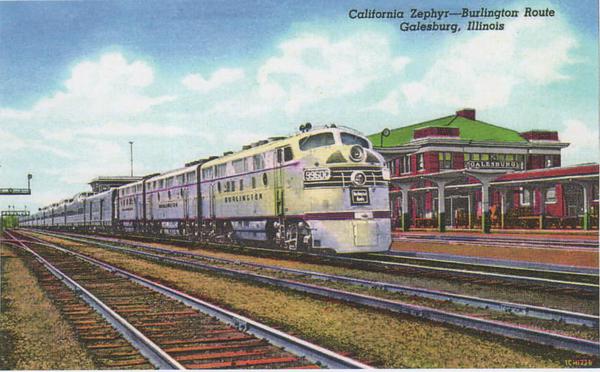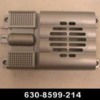I got in on this discussion right away within 10 minutes of your initial post and was corrected- not sure why his redirect and implied disregard of previous was made- this is based solely on what you the modeller wants to do.. Your era of time frame. These locomotives during the silver "aluminum" paint time frame had very few mods made by the shops from the factory. To most of us Q aficionados the usual maint dept changes implemented during shopings.
I deleted my response.
After some thought I am going to add some notes here that are missing. I was waiting for the details from someone else.
All photos are copyright and used for research and educational use only:
These locomotives were modified 1-2 times after arrival from La Grange in 10/47 and stayed this way while used in passenger service likely 1949-1950 shopings as they came in. The Q did not like the F's in passenger service and retired them in 1954- regeared to freight specs in 1955. The mods are simple Q standard requirement maintenance grabs; factory improved number boards were also different than the small side view only boards found on many F3's of the time.
(From our friends at the Q Historical Society)
A third batch of Phase II F3's, also A/B/A sets, was purchased at the same time, but these were intended for passenger service on the new California Zephyr. Numbered 9960-9962, they were delivered in the passenger paint scheme of silver (aluminum paint) with black striping and lettering. They were the only F-units on the system with steam generators (in both the A- and B-units) and were the only ones lacking dynamic brakes. After they were bumped from the Zephyr in the early Fifties, they were regeared for freight service in 1955 and eventually repainted in the freight scheme. They kept their passenger numbers to the end, however.
9960A 10/47 4424 1 unit of ABA set #9960 Traded in on GP35 9/64 7
9960B 10/47 4430 1 unit of ABA set #9960 Traded in on GP40 1/67 7
9960C 10/47 4425 1 unit of ABA set #9960 SFS to PECO 11/65 7
9961A 10/47 4426 1 unit of ABA set #9961 Traded in on GP35 10/63 7
9961B 10/47 4431 1 unit of ABA set #9961 Traded in on GP35 10/63 7
9961C 10/47 4427 1 unit of ABA set #9961 Traded in on GP35 7/63 7
9962A 10/47 4428 1 unit of ABA set #9962 Traded in on GP35 9/63 7
9962B 10/47 4432 1 unit of ABA set #9962 Traded in on GP35 8/64 7
9962C 10/47 4429 1 unit of ABA set #9962
Those are cut-levers on the sides of the pilots. Standard passenger pilot feature. The Q liked the passenger pilots using them on "gray-back" freight units also. I did notice the Atlas model has the freight pilot- ooopps

Mods include over the windshield and between to hood grabs and antenna. Also typical Q hood grabs and walkway for crew on engineer side as seen in your posted photo with the green circle (good job!). Photo courtesy M Powell taken 2/26/56 in freight service

Pilots remained the same except removal of factory doors. I'm uncertain for an exact date but likely on the first annual shoping. The E's were also modified similarly.
Unmodified views taken in 1947 used on train 39 the Exposition Flyer





Further mods included the "F3" plaque on the side of the cab.


A nice color view taken prior to mods 3/24/48 by C.H. Kerrigan (it could be noted that the mods to the pilot and maint grabs were carried out in 1950 or beginning in 1950 through 1952 as the locomotive sets were brought in on shopings)


Views showing mods performed on pilots. Removal of doors cut-levers remained the same in freight service as of the 2/26/56 top view
It's also worth noting the Gyra Light assembly stayed the same while in silver. The Pyle sealed units must have been installed after 1957.

Your notes on this photo are great- the red note is a standard passenger pilot cut-lever the locomotive was delivered with this design. You did note the maint crew walkway grab; look carefully right behind the anti-climber and you will see an "L" shaped walkway that protrudes about a scale 10" from the side of the cab related to the standard Q practice of maint grab work. It appears that this was done early in the locomotives life. It can be surmised at least two different sets of mods were completed before the end of the locomotives career as a passenger unit in 1955.

Standard issue Q maint dept drawing explaining to installation dept heads the required safety additions to all units. Shows the maint grab installations you have noted on your photo. (C) Jerry Albin Collection
![]()





